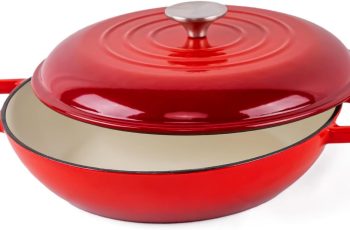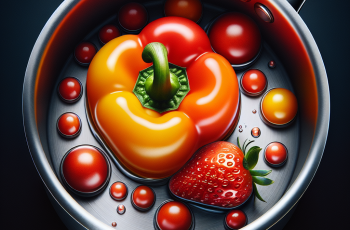Ad Blocker Detected
Our website is made possible by displaying online advertisements to our visitors. Please consider supporting us by disabling your ad blocker.
In this article, you will learn about the safety precautions and helpful tips for using a Dutch oven for deep frying. Whether you’re an experienced cook or a novice in the kitchen, understanding the proper techniques and precautions is crucial when using this versatile kitchen tool for deep frying. By following these guidelines, you can ensure a safe and successful deep frying experience, achieving deliciously crispy results every time.
Safety Tips for Using a Dutch Oven for Deep Frying
Deep frying with a Dutch oven can be a rewarding experience, but it is essential to follow certain safety precautions to ensure that the process is carried out safely and effectively. In this article, we will discuss some safety tips for using a Dutch oven for deep frying.
Choose the Right Dutch Oven
When deep frying, it is important to choose the right Dutch oven. Opt for a heavy-duty Dutch oven that can withstand high temperatures and distribute heat evenly. A Dutch oven made of cast iron or stainless steel is ideal for deep frying as it retains heat effectively and provides even cooking.
Use the Proper Amount of Oil
Using the proper amount of oil is crucial for deep frying. Before you start frying, determine the amount of oil needed based on the size of the Dutch oven and the food you are frying. Overfilling the Dutch oven with oil can lead to dangerous oil overflow and potential fires. Ensure that you have enough oil to fully submerge the food, but without exceeding the recommended fill line of the Dutch oven.
Monitor the Temperature
Maintaining the correct temperature of the oil is essential for achieving crispy and evenly cooked food. Use a deep-fry thermometer to monitor the oil temperature throughout the frying process. Different foods require different temperature settings, so refer to your recipe for the recommended temperature and adjust the heat as necessary to maintain a consistent temperature.
Keep the Lid Handy
Having the lid of the Dutch oven readily available is important for safety reasons. If a fire were to occur, immediately covering the Dutch oven with the lid can help cut off the oxygen supply and extinguish the flames. The lid also acts as a shield, protecting you from hot oil splatters. Always keep the lid nearby while deep frying and ensure that it fits tightly on the Dutch oven.
Be Cautious of Hot Oil Splatters
Hot oil splatters are a common hazard when deep frying. To minimize the risk of oil splatters, avoid adding wet or frozen foods directly into the hot oil. Moisture can cause the oil to splatter and potentially cause burns. Slowly lower the food into the oil to prevent excessive splattering. If you want an extra layer of protection against splatters, consider using a splatter screen or covering the Dutch oven with a lid while frying.
Use Heat-Resistant Gloves or Oven Mitts
To protect your hands and arms from burns, it is crucial to use heat-resistant gloves or oven mitts when handling a Dutch oven for deep frying. Look for gloves or mitts specifically designed for high-temperature cooking to ensure they provide sufficient protection. Additionally, choose gloves or mitts with a good grip to avoid accidents caused by a slippery grip on the Dutch oven or utensils.
Never Leave the Dutch Oven Unattended
Deep frying requires constant attention and supervision. Never leave the Dutch oven unattended while the oil is heating or while food is frying. Oil can reach dangerous temperatures quickly, and unattended oil can lead to fires or accidents. Stay diligent and focused on the frying process, and prepare in advance by having all the necessary tools and ingredients ready before you start.
Do Not Overcrowd the Dutch Oven
To maintain the desired cooking temperature and ensure optimal frying results, avoid overcrowding the Dutch oven with food. Adding too much food at once can lower the oil temperature significantly, resulting in greasy and undercooked food. It is best to fry in smaller batches, allowing enough space for the food to cook evenly and for the oil to circulate freely.
Carefully Lower and Remove Food from the Oil
When adding and removing food from the hot oil in the Dutch oven, it is important to do so carefully to prevent oil splatters and burns. Use long tongs or a slotted spoon to lower the food into the oil gently. Avoid dropping food in from a height, as this can cause splattering. When removing the food, use the same utensils to lift it out slowly, allowing excess oil to drain back into the Dutch oven.
Handle Hot Dutch Oven with Care
After deep frying, the Dutch oven will be extremely hot, and handling it requires caution. Always use oven gloves or mitts specifically designed for high-temperature applications when touching the Dutch oven. Place the hot Dutch oven on a heat-resistant surface, such as a trivet or heat-proof countertop, to avoid damaging your work surface. Allow the Dutch oven sufficient cooling time before attempting to clean or move it.
Preparing the Dutch Oven for Deep Frying
Before you start deep frying with a Dutch oven, it is important to properly prepare it to ensure a safe and enjoyable cooking experience.
Clean and Dry the Dutch Oven
Start by ensuring that the Dutch oven is clean and dry. Remove any residues or food particles from previous uses that may affect the quality and taste of the fried food. Clean the Dutch oven with warm, soapy water and a non-abrasive sponge or cloth. Rinse it thoroughly with clean water and dry it completely to prevent water from splattering when the oil is added.
Choose the Right Cooking Oil
Choosing the right cooking oil is essential for achieving desired frying results. Different oils have different smoke points, which is the temperature at which the oil starts to break down and produce smoke. Opt for a cooking oil with a high smoke point, such as canola, peanut, or vegetable oil. These oils can withstand high frying temperatures without smoking excessively, resulting in cleaner and tastier fried food.
Preheat the Dutch Oven and Oil
Before adding the food, preheat the Dutch oven and oil to the desired frying temperature. This is especially important for achieving crispy and evenly cooked food. Place the Dutch oven on the stovetop over medium heat and add the desired amount of oil. Allow the oil to heat gradually until it reaches the desired temperature. Preheating the Dutch oven and oil ensures that the food cooks properly and absorbs less oil during the frying process.
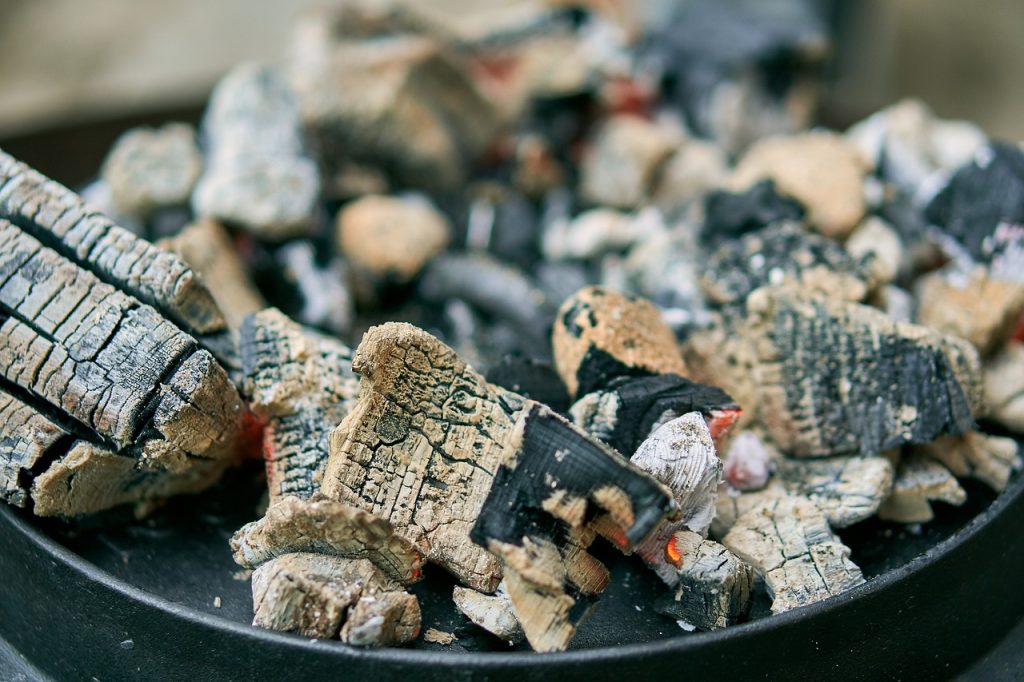
Choosing the Right Dutch Oven for Deep Frying
Selecting the right Dutch oven for deep frying is crucial for achieving optimal cooking results and ensuring safety in the kitchen.
Opt for a Heavy-Duty Dutch Oven
When choosing a Dutch oven for deep frying, look for one that is heavy-duty and built to withstand high cooking temperatures. Dutch ovens made from cast iron or stainless steel are excellent choices, as they retain heat efficiently and distribute it evenly, resulting in consistent frying results. The heavy construction also provides stability and reduces the risk of accidents caused by tipping or spilling.
Ensure the Dutch Oven has a Tight-Fitting Lid
A tight-fitting lid is an essential feature of a Dutch oven for deep frying. The lid helps control the temperature by trapping heat inside, resulting in faster and more even cooking. Furthermore, the lid acts as a safety measure, as it can be used to smother flames in case of a fire. Before purchasing a Dutch oven, ensure that it comes with a lid that fits securely and seals properly.
Consider the Size and Shape of the Dutch Oven
The size and shape of the Dutch oven are also important considerations when deep frying. The Dutch oven should be large enough to accommodate the desired amount of food without overcrowding. However, it should not be too large, as this can lead to excessive oil usage and inefficient heating. Additionally, consider the shape of the Dutch oven to ensure that it fits comfortably on your stovetop and allows for even heat distribution.
Using the Proper Amount of Oil in a Dutch Oven
Using the right amount of oil in a Dutch oven is essential for achieving great frying results and minimizing the risk of accidents.
Determine the Amount of Oil Needed
To determine the amount of oil needed, it is important to consider the size of the Dutch oven and the food you are frying. The oil should be sufficient to fully submerge the food without overflowing when the food is added. Refer to your recipe or general guidelines for the recommended oil quantity based on the food you are frying. Filling the Dutch oven with too much oil can lead to dangerous oil overflow and potential fires.
Do Not Overfill the Dutch Oven with Oil
While it is important to have enough oil to adequately fry the food, overfilling the Dutch oven with oil can be dangerous. When the food is added, it displaces the oil, causing it to rise and potentially overflow. This can lead to oil fires or injury due to hot oil splattering. To avoid overfilling, ensure that the oil level is well below the rim of the Dutch oven and does not go beyond the recommended fill line.
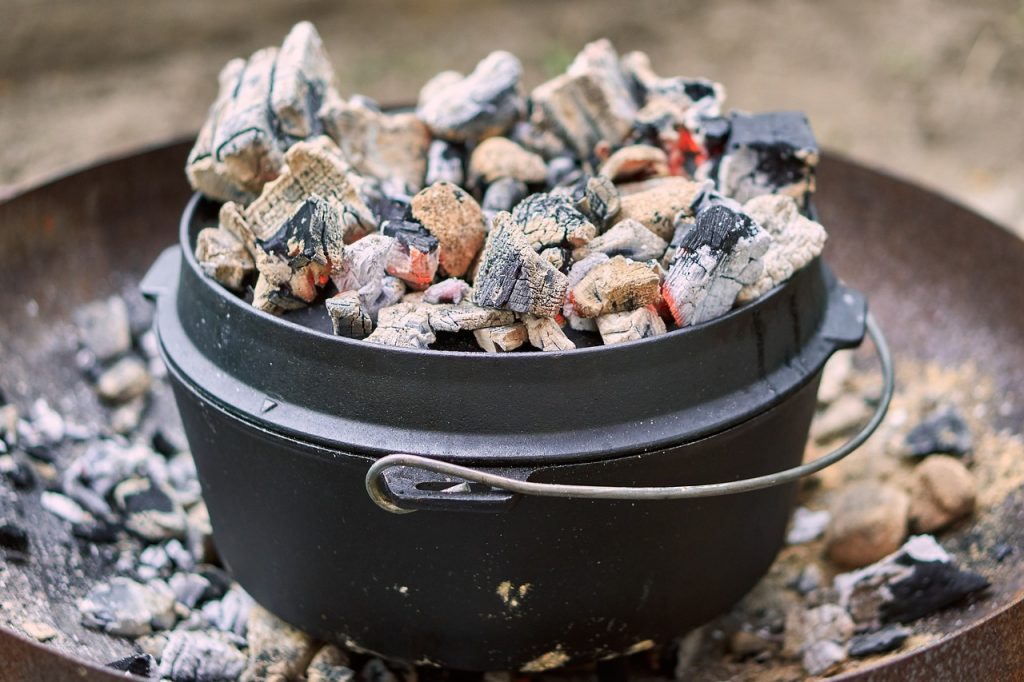
Monitoring the Temperature of the Oil
Maintaining the optimal temperature of the oil is crucial for achieving crispy and evenly cooked food. Proper temperature control ensures that the food cooks thoroughly without absorbing excessive oil. Here are some tips for monitoring the temperature of the oil when deep frying in a Dutch oven.
Use a Deep-Fry Thermometer
A deep-fry thermometer is a useful tool for accurately measuring the temperature of the oil. It can be immersed in the hot oil and has a temperature range suitable for deep frying. Attach the thermometer to the side of the Dutch oven, ensuring that the tip is fully submerged in the oil without touching the bottom. This allows you to monitor the temperature throughout the frying process and make adjustments as necessary.
Maintain the Optimal Temperature
Different foods require different frying temperatures to achieve optimal results. Consult your recipe for the recommended frying temperature and adjust the heat accordingly. Once the desired temperature is reached, it is important to maintain it throughout the frying process. Failure to maintain the optimal temperature can result in greasy or undercooked food. Monitor the thermometer closely and adjust the heat as needed to ensure a consistent frying temperature.
Adjust the Heat as Needed
Depending on the type of stove and Dutch oven you are using, it may be necessary to adjust the heat to maintain the desired temperature. Gas stoves heat up and cool down quickly, so you may need to adjust the flame to maintain a steady temperature. Electric stoves take longer to heat up and cool down, so make sure to monitor the heat and adjust as necessary to achieve and maintain the desired frying temperature.
The Importance of Keeping the Lid Handy
When deep frying with a Dutch oven, having the lid readily available is essential for safety and control. Here are some reasons why keeping the lid handy is important during the frying process.
Protect Yourself and Others from Oil Splatters
Hot oil splatters can cause painful burns and pose a significant safety risk. By keeping the lid of the Dutch oven nearby, you can quickly cover the pot in case of oil splatters. Immediately covering the Dutch oven with the lid helps to cut off the oxygen supply, extinguishing any flames caused by the oil splatters. Always keep the lid within arm’s reach when deep frying to ensure your safety and the safety of others in the kitchen.
Control the Heat and Prevent Oil Fires
In the event of a fire during deep frying, having the lid accessible allows you to quickly smother the flames. The lid can be placed on top of the Dutch oven, covering it completely and cutting off the oxygen supply. This helps to control the fire and prevent it from spreading. However, it is important to exercise caution and only attempt to extinguish the fire if it is safe to do so. If the fire becomes unmanageable or poses a threat, evacuate the area immediately and call emergency services.
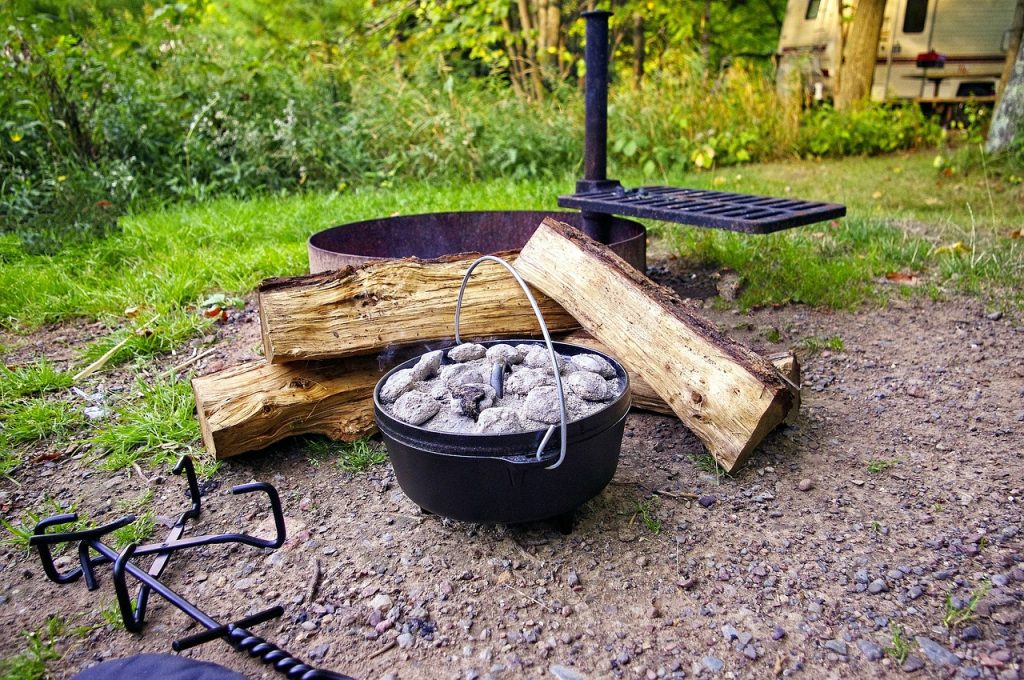
Being Cautious of Hot Oil Splatters
Hot oil splatters are a common hazard when deep frying with a Dutch oven. Taking precautions to minimize the risk of oil splatters is essential for safety in the kitchen.
Avoid Water and Wet Foods
Combining hot oil and water or wet foods can lead to violent oil splatters and potentially cause burns. Always ensure that the food to be fried is dry and free from excess moisture before adding it to the hot oil. Thoroughly pat dry any wet or marinated foods to minimize the risk of oil splatters. Avoid adding ice or frozen foods directly to the hot oil, as the temperature difference can lead to rapid and dangerous oil splattering.
Slowly Lower Food into the Oil
When adding food to the hot oil in the Dutch oven, it is important to do so slowly and carefully. Quickly dropping the food into the oil can cause the oil to splatter and potentially result in burns. Use long tongs or a slotted spoon to gently lower the food into the oil, allowing it to seep in gradually. By adding the food slowly, you reduce the chances of oil splatters and create a safer cooking environment.
Use a Splatter Screen or Lid
For an added layer of protection against oil splatters, consider using a splatter screen or covering the Dutch oven with a lid while deep frying. Splatter screens are mesh screens that can be placed on top of the Dutch oven, allowing steam to escape while blocking oil splatters. The mesh screen prevents oil from reaching you or other surfaces, reducing the risk of accidents. If a splatter screen is not available, lean a lid slightly away from you to create an opening that allows steam to escape while still minimizing oil splatters.
Using Heat-Resistant Gloves or Oven Mitts
When deep frying with a Dutch oven, protecting your hands and arms from burns is of utmost importance. Using heat-resistant gloves or oven mitts can help ensure your safety while handling hot cookware.
Protect Your Hands and Arms
Heat-resistant gloves or oven mitts provide a barrier between your skin and the hot Dutch oven. They are designed to handle high temperatures and protect your hands and arms from burns. Always use gloves or mitts specifically designed for high-temperature cooking to ensure they provide adequate protection.
Choose Gloves or Mitts with Good Grip
In addition to heat protection, it is important to choose gloves or mitts with a good grip. The surfaces of Dutch ovens can be slippery, especially when greasy or wet, and a secure grip is crucial to prevent accidents. Look for gloves or mitts with textured surfaces or silicone grips to ensure a firm hold on the Dutch oven and any utensils used during deep frying.
Never Leaving the Dutch Oven Unattended
One of the most important safety tips for deep frying with a Dutch oven is to never leave it unattended. Constant supervision is crucial throughout the frying process to ensure a safe cooking experience.
Stay Diligent and Focused
Deep frying involves working with hot oil, which can be extremely dangerous if left unattended. Avoid distractions and remain focused on the frying process. By staying diligent and constantly monitoring the Dutch oven and the oil, you can quickly address any potential issues before they escalate into accidents or fires.
Prepare in Advance and Have Everything Ready
Before starting the deep frying process, it is essential to prepare in advance and have everything ready. Organize your ingredients, utensils, and tools before you begin frying. This allows you to work efficiently and ensures that you do not need to leave the Dutch oven unattended to gather supplies. By having everything ready, you can maintain constant supervision and minimize the risk of accidents or mishaps.
Handling a Hot Dutch Oven with Care
After deep frying, the Dutch oven will be extremely hot and require careful handling to prevent burns or accidents. Here are some tips for safely handling a hot Dutch oven.
Use Oven Gloves or Mitts
When handling a hot Dutch oven, it is crucial to protect your hands and arms with oven gloves or mitts specifically designed for high-temperature cooking. These gloves provide insulation and prevent burns caused by direct contact with the hot cookware. Ensure that the gloves cover your hands, wrists, and part of your forearms for optimal protection.
Place on a Heat-Resistant Surface
When setting down a hot Dutch oven, always place it on a heat-resistant surface to avoid damaging your work surface or countertops. Use a trivet or heat-resistant pad to create a protective barrier between the Dutch oven and the surface. Avoid placing the hot Dutch oven on any surface that can be damaged by heat or that may conduct heat, such as plastic or bare wood.
Allow Sufficient Cooling Time
After deep frying, allow the Dutch oven sufficient time to cool down before attempting to clean or move it. The cast iron or stainless steel material retains heat for a significant period, and attempting to handle or clean the Dutch oven while it is still hot can result in severe burns. Be patient and wait until the Dutch oven has cooled down to a safe temperature before taking any further action.
In summary, deep frying with a Dutch oven can be a delightful cooking method, but it requires adherence to specific safety guidelines. Choosing the right Dutch oven, using the proper amount of oil, monitoring the temperature, keeping the lid handy, being cautious of hot oil splatters, using heat-resistant gloves or oven mitts, never leaving the Dutch oven unattended, not overcrowding the Dutch oven, carefully lowering and removing food from the oil, and handling a hot Dutch oven with care are all essential for safe and successful deep frying. By following these safety tips, you can confidently enjoy the art of deep frying while minimizing the risk of accidents and ensuring delicious results every time.
